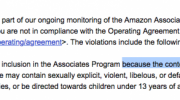A post yesterday on liberal politics site PoliticsUSA.com is headlined “Proof That Homophobia Is Associated with Homosexual Arousal.” In it, writer Sarah Jones makes reference to a Psych study at the University of Georgia in which authors HE Adams, LW Wright, and BA Lohr strapped some college boys into dick sleeves and showed them porn.
The authors of this study came to the conclusion that homophobia is associated with homosexual arousal. This claim seems guaranteed to make the bloggy rounds this week. It’s compelling stuff, to be sure, but the study is actually from 1996. Jones acknowledges this fact, but only after the money shot. Even Nathan Heflick’s Psychology Today commentary on the topic that Jones cites is from June of this year.
In my world, no one ever needs to go searching for reasons to talk about strapping college boys into electrified dick-sleeves and showing them porn. However, once someone starts calling it “proof,” steam comes out my ears — and not in a cool, steampunk sort of way.
“Proof” is a big word. The 1996 study, by any reasonable scientific benchmark, wasn’t it. And if right-thinking non-homophobes start looking for “proof” that homophobes are barking out bullshit, I believe we open the door for other sketchy “scientific” claims about sex, gender and sexuality — which come far more often from the anti-sex commandos than from pro-sex activists.
Here’s how Heflick (accurately) summarized the findings for Psychology Today:
When viewing lesbian sex and straight sex, both the homophobic and the non-homophobic men showed increased penis circumference. For gay male sex, however, only the homophobic men showed heightened penis arousal.
Heterosexual men with the most anti-gay attitudes, when asked, reported not being sexually aroused by gay male sex videos. But, their penises reported otherwise.
[Link.]
I can attest, albeit on an anecdotal basis, that penises can indeed be some naughty bunnies.
This 1996 Adams, Wright and Lohr study is a fairly famous one; it set out to test a central Freudian idea: That people have negative attitudes toward sexual things they secretly crave. It is a sign of Freud’s fall from grace in the public view that I see the UGA study, or some garbled, half-remembered version of it, cited far more often than Freud’s thinking as evidence that homophobia equals same-sex attraction.
There are some other fascinating studies that explore homophobia and aggression, like the 2001 study, also from the University of Georgia, that demonstrated homophobic men were more willing to administer pain to (fictitious) gay men, but not to straight men, after viewing gay porn, and the 2006 University of Kentucky study that found that a male subject’s psychopathy was a significant predictor of his anger and aggression toward gay men, but not toward straight men.
These are all pieces of a very interesting puzzle, but in no way are they scientific “proof” of anything.
In fact, I consider presenting this stuff as “proof” to be no better or worse in scientific terms than the “proof” routinely presented by anti-porn activists that porn makes men misogynistic, or that men who visit prostitutes become criminals, or even by (perhaps) well-intentioned doctors that porn will make you impotent. The University of Georgia and University of Kentucky studies are better studies — far better studies, to be sure.
But studies don’t have to “prove” something to be good studies, and just because they’re good studies doesn’t mean they proved something. A study may suggest or demonstrate something that may be clinically valuable, but the desire for a cheap, sleazy “studies have shown” soundbite does not mean that science — real science — is obligated to produce such a soundbite.
To my mind, the 1996 study (like so many studies in sexuality) has some significant limitations, most notably its small size — the entire study consisted of 64 men. The results might provide tantalizing suggestions for further study, and I’ll even cut the authors some slack for their facile conclusions, since facile conclusions are (unfortunately) the name of the game in the academic study of human sexuality. But a single study of 64 men in 1996 is hardly a reason to posit arguments about the essential nature of human desire. I believe, in fact, that it’s dangerous to do so; such sweeping generalizations have a way of cheapening social dialogues.
I’m not arguing that homophobia is not related to secret, denied and/or hidden homosexual desire. Clearly, in some cases it is. It is clearly connected to the fear of homosexual desire in many cases. And I’d be willing to bet my hard-earned that homophobia is connected to hidden homosexual desire a lot of the time, and a frustration with heterosexual sex a lot of the time if it’s not connected to secret gay lust. Why? Because great heterosexual sex is a life-changing event, and I believe that having it regularly inhibits homophobia — and all sex-related phobias — rather than augmenting the fear or hatred of its perceived “opposite.” I just can’t believe that someone who is really getting happily and productively laid (by themselves or someone else, or both) can sit around obsessing how awful it is that someone else is doing something else. If you’re seriously happy with your sex life, why should you give a shit? My supposition may not be scientific, and it doesn’t “prove” anything, but I want to make it clear that I’m not distrusting the idea that homophobia and fear are connected…I’m distrusting the idea that it can, or has, been proven…or that it needs to be.
That’s all well and good, but what’s really important about the 1996 University of Georgia study is that it involves creepy machine sex.
No, seriously…creepy. And, I admit sheepishly, hot. But then, creepy and hot aren’t always diametrically opposed.
See, it’s like this: the docs put a cuff on the guys’ dicks to measure their erections, and made them watch gay porn. Is it getting hot in here, or is that just my penile cuff overheating?
Importantly, the device that measures boners is called a penile plethysmograph. Heflick reports that it reliably reacts to sexual arousal but not to other kinds of arousal — that is, “nervousness or fear,” which can also cause erections. Basically, the penile plethysmograph measures whether guys get hard when they’re watching a particular type of porn, allowing scientists to document just what bad little piggy really wants…er…that is, what the physiological penile response to stimulation is, and whether it comes, credibly, from sexual arousal rather than fear.
Incidentally…if I were wearing a penile plesysmograph right now, it’d be making lots of bing-bing-bing! noises.
That’s because I’m imagining that every Dominatrix reading this must be popping a soul-boner and furiously Googling “buy penile plethysmograph overnight shipping” while hauling their credit cards out of leopard-print, rhinestone-studded purses.
Anyway, the 1996 study all makes some seriously hot one-handed reading for machine-sex aficionados, science-porn freaks and dreamers-up of complicated fantasies where biker-bars full of super-butch homo he-men corner and brutally Melvin homophobic southern college boys only to discover they’re yanking not on a University of Georgia jock strap, but on a pair of pretty pink panties Southern Boy’s frat brothers made him wear to the gay biker bar. If facile, essentializing conclusions can be drawn from sixty straight men in Georgia getting boners or not getting boners when they watch gay porn…then what kind of conclusions can be drawn about people who get aroused reading scientific studies about laboratory testing of homophobia and homosexual arousal? You tell me. Here’s most of the abstract from the original study (PDF link warning)
The authors investigated the role of homosexual arousal in exclusively heterosexual men who admitted negative affect toward homosexual individuals. Participants consisted of a group of homophobic men (n = 35) and a group of nonhomophobic men (n = 29); they were assigned to groups on the basis of their scores on the Index of Homophobia (W. W. Hudson & W. A. Ricketts, 1980). The men were exposed to sexually explicit erotic stimuli consisting of heterosexual, male homosexual, and lesbian videotapes, and changes in penile circumference were monitored…both groups exhibited increases in penile circumference to the heterosexual and female homosexual videos. Only the homophobic men showed an increase in penile erection to male homosexual stimuli. The groups did not differ in aggression. Homophobia is apparently associated with homosexual arousal that the homophobic individual is either unaware of or denies.
[Link.]
What worries me is that reposting old studies out of context, with the age of the study buried in the post, tends to reify the same old information in a new context.
Jones’ PoliticsUSA post says that the data is “never as relevant as it is today as Republican candidates take to the stage to squeal that they will repeal DADT and make gay marriage illegal on a federal level, while ignoring jobs and the economy.”
I couldn’t disagree with her more. The roots of homophobia never stopped being relevant.
We don’t need homophobic politicians to tell us that homophobia, like misogyny, is one of the central forces that drives gender norming — and, by extension, all American society. And I believe it’s downright dangerous to pretend that a study of sixty-four men can wrap up any meaningful argument about what causes homophobia.
To her credit, Jones basically says something pretty similar:
Most people simply don’t care what strangers do with their life. It’s beyond telling when a political party and so called religion come together in service of this kind of hate. Fear often drives the individual; fear of their own desires and fear of their own choices.
[Link.]
If homophobia is about fear, it is by its nature about arousal, which we don’t need science to tell us. A small study from more than a decade ago may provide provocative results that start great conversation about hate, fear, and homophobia.
But like all proclamations of scientific “proof” based on small studies, calling it “proof” is downright dangerous.
As far as I’m concerned, if we’re going to talk science, we’re owed a higher level of study. The respect for what “proof” would or wouldn’t look like in this context is as important as taking a stand against homophobia, because homophobia is about qualitative, proscriptive or prescriptive lies, whereas science is about descriptive truth. Treating scientific principles lightly, even if your heart’s in the right place, does everyone a disservice.
Image: Model Philip Ellis, photographed by Damon Baker. Via Homotography.






I liked this tweet from @coyotetoo last week:
“Homophobia: the fear that gay men will treat you the way you treat women.”
pzed, I wonder if that finding might tie into idea that homophobia mutilates homophobic men’s inner lives because it makes intimacy with other men terrifying and prohibited. Niobe Way’s new book “Deep Secrets: Boys’ Friendships and the Crisis of Connection” describes the pain and depression of late-adolescent boys if they feel they have to sacrifice either their close male friendships or their hetero masculinity.
(There was a feature in the NYTimes about her last September: http://www.nytimes.com/2011/09/22/fashion/seeking-to-help-boys-keep-their-friends.html?_r=1.)
It’s been a theme in queer theory for a while: in Eve Sedgwick’s first major book “Between Men,” for example, or in George Chauncey’s argument not that Lincoln was gay, but that many more relationships, erotic & not erotic, were available for men — like Lincoln’s romantic friendship with Joshua Speed — before homophobia was so firmly established in the US.
So I wonder if part of the anger homophobic men reported in that study when they looked at pictures of non-sexual intimacy between men has something to do with their internal prohibition against exactly that. Like, hating that other men get to have that intimacy, or hating that it’s forbidden to them, or hating how much they want it & how scared that makes them feel.
The paper is a little old, but I checked Web of Science to see if it’s had any impact. It has been cited 77 times, which is actually quite good, and many of those citations are very recent including a number within the last year. On article that cites this one and that might interest you is “Heterosexual Men’s Anger in Response to Male Homosexuality: Effects of Erotic and Non-Erotic Depictions of Male-Male Intimacy and Sexual Prejudice”, by Hudepohl Adam D.; Parrott Dominic J.; and Zeichner Amos (Journal of Homosexuality 57.8, 2010 DOI: 10.1080/00918369.2010.503505). Sadly, Hudepohl et al. do not discuss penile cuffs. But they do say this:
“The finding that sexually prejudiced men reported comparably large increases in anger regardless of the type of male-male stimulus video used (i.e., sexual, nonsexual) has interesting but unclear theoretical implications. Men appear to be angered by witnessing male-male sexual activity regardless of their level of sexual prejudice, but only those who report high levels of sexual prejudice are angered by non-erotic male-male relationship behavior. Perhaps men who report high levels of sexual prejudice imagine sexual contact between two male partners when they witness them involved in common and publicly seen relationship behaviors. This speculation would be in keeping with previous research on sexually prejudiced men’s experience of sexual arousal in response to male homosexuality (Adams, Wright, & Lohr, 1996).”
I don’t care WHY they wanna do it. NOBODY is going to wrap an electronic or electric or wired sleeve of any kind around my crotch! No, Nay, Negative, Na-ah, Ain’t gonna happen.
I’m still upset about electrically flushed toilets. Those things have electricity at the top and and water (a ground) at the bottom end. I’m supposed to put my “best friend” in between the two of those? In a circuit diagram, that’s called a FUSE! The wired sleeve is essentially the same diagram.
No.
Yes, yes it is. If you want evidence, just look at all the Republicans who hate on homosexuals and then are caught in a homosexual relationship. It’s all about fear of accepting who you are. They are just too small-minded and emotionally stunted to accept their true feelings. So they lash out against that which they fear, that which they truly are, instead of accepting and embracing it.